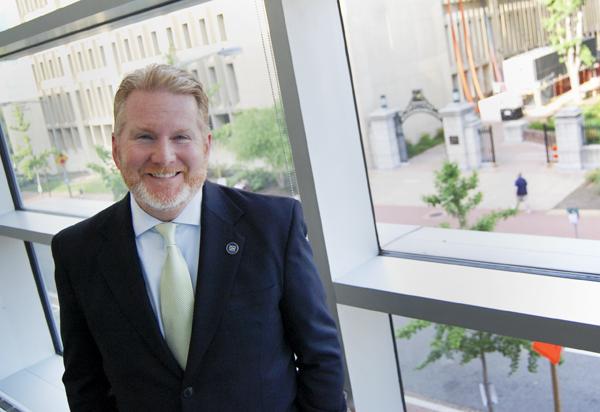Despite capturing the University’s largest-ever gift last month, administrators and trustees are still weighing one of the most critical questions for GW’s fundraising future: When do they start a potential $1 billion campaign?
The launch date for the University’s largest-ever fundraising campaign could still be a year away, hinting at a slower-than-expected pace of donations to hoist academics, research and construction over the next decade.
Vice President for Development and Alumni Relations Michael Morsberger had said the likely $1 billion funding drive could launch as soon as this year’s Commencement, but said this week that the Board of Trustees would likely decide to take several more months before going public.
“I don’t have an answer yet. I know I’ve been saying that for two years but that’s just the nature of these things,” Morsberger said in an interview this week.
He said the decision is driven by numbers such as the total amount of money raised, the rates of alumni donors and the chances of bigger gifts coming down the pipeline. The possible delay comes even as GW’s fundraising campaign has revved up with two of GW’s largest-ever gifts and the purchase of a major D.C. arts landmark this year.
The Board of Trustees will debate the campaign’s starting point – as well as the total fundraising goal – for the third time this academic year at the May meeting, which takes place during Commencement weekend.
The University’s campaign is now in its third year of the “quiet phase” – the several years before an official launch in which fundraisers build partnerships and grow momentum – which is the average length of quiet phases nationwide, according to a report by the Council for Advancement and Support of Education.
Morsberger said the Board could decide to kick off the campaign in the next few months, sometime this fall or next year. It will likely go public in line with a large University milestone, which Morsberger said could mean the opening of the GW Museum and Textile Museum by the end of 2014 or that of the Science and Engineering Hall in spring 2015.
In January, Morsberger hinted that the University would announce three large donations by the end of the academic year, but with graduation a month away, only one has been announced – a combined $80 million donation for the public health school from billionaire philanthropists Michael Milken and Sumner Redstone.
That gift, which came in last month, brought GW’s quiet phase fundraising total to more than $300 million, heating up the campaign but not preparing it to go public, Morsberger said.
David King, a 25-year fundraising expert who runs fundraising consulting firm Alexander-Haas, said organizations wait until there is enough momentum – and a certain level of fundraising – built up to successfully launch a campaign.
About one-third of universities rake in about 60 percent of their projected fundraising goals before going public with their campaigns, according to CASE data.
Universities are often strategic about who to include during the quiet phases to help corral those who can give large donations, King added.
“You treat them as insiders so they feel like they can shape the direction of the campaign and then when you get to the point when you’ve exhausted them, then you formulate your plan for the public phase,” King said.
As the recession has forced universities across the country to take extra time to court deep-pocketed donors, the average length of a quiet phase has creeped up by about six months, according to CASE data from 2011. A full campaign lasts an average of about seven years.
Georgetown University took about five years to announce its current $1.5 billion campaign. Vanderbilt University spent four years planning and courting donors, before pulling in almost $2 billion.
Campaigns typically launch publicly after a major gift, said William Walker, an interim vice president who focuses on research at CASE. That means sending hundreds of fundraisers across the country to visit pockets of highly concentrated alumni and other stakeholders.
That type of highly public launch “can have the effect of inspiring other major gift prospects,” Walker said.
In preparation for the campaign launch, GW overhauled its branding, continued to bulk up its fundraising office and elevate the importance of dean fundraising.
Fundraising campaigns have also picked up in the wake of the recession, when donations stagnated at most institutions. Eleven of the 14 schools GW considers its top competitors have recently launched their fundraising campaigns, nearly all with a goal of at least $1 billion.
As the University gears up for its much-anticipated public phase, Morsberger said he will spend far more time traveling to court large donors.
The University has also hired more top-level positions, cutting down on Morsberger’s management load inside the office. He now oversees four people, down from about 12 direct reports when he started at GW in 2010.
“It’s become self-evident that as much as possible I need to get out of meetings and on the road,” he said. “The more contact you make, the more money you raise.







